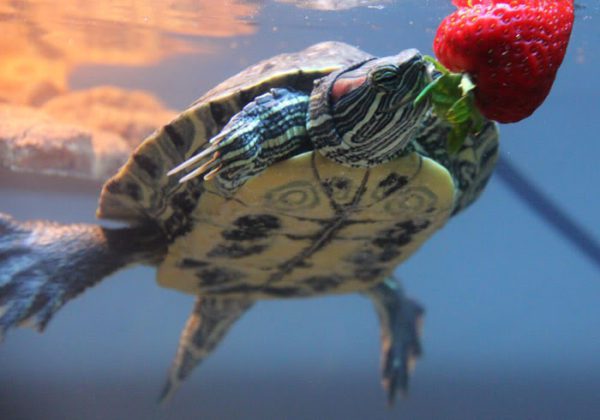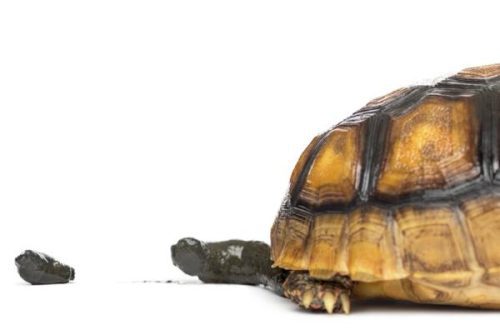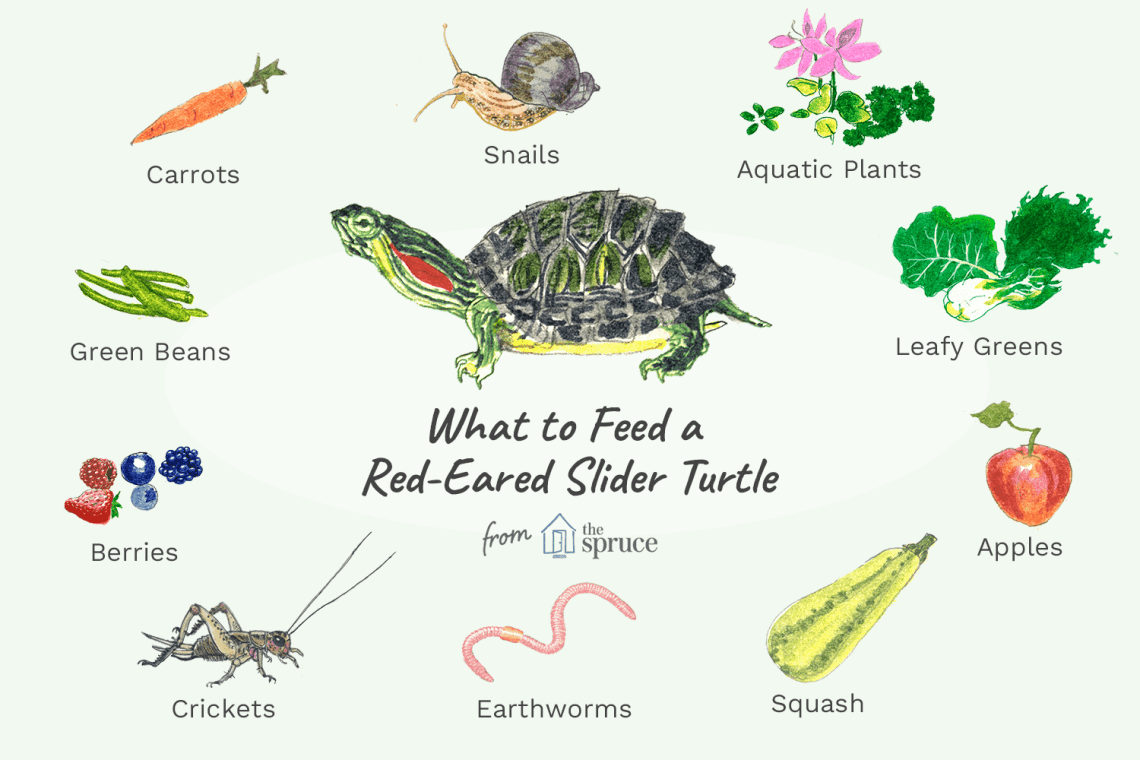
How to feed a red-eared turtle: rules for feeding at home, lists of foods that can and cannot be given to reptiles
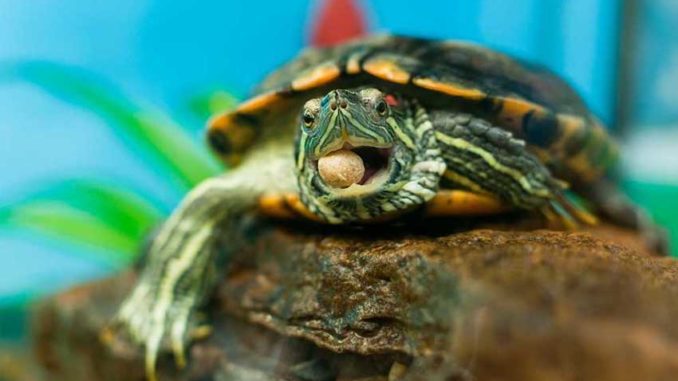
A proper diet is the main factor that determines the longevity of a pet.
Let’s look at allowed and prohibited foods for red-eared turtles and figure out how to properly feed aquatic reptiles.
Contents
Permitted products
Up to a year, freshwater reptiles lead a predatory lifestyle, but with age they lean more and more on plants, vegetables and fruits. Because of this feature, red-eared turtles are classified as omnivores, and their diet is based on 2 types of food:
- an animal that makes up 70-90% of the diet;
- vegetable, constituting 10-30% of the diet.
IMPORTANT! At home, red-eared turtles willingly eat ready-made industrial feeds, which makes them easier to keep.
In addition to the main food sources, the diet should include vitamins and minerals. For turtles, eggshells and bone meal, rich in calcium, will be useful.
Animal feed
From food of animal origin, red-eared turtles can be given:
- Offal. You can feed your pet with boiled offal (beef or chicken liver and heart) to eliminate parasite infestations.
- Fish and Seafood. River and sea fish must be cleaned of large bones and held in hot water to remove thiaminase, an enzyme that destroys vitamin B1 and poses a threat to the nervous system. Shrimp, octopus and mussels can be fed frozen from a sea cocktail or fresh.
- Insects. Red-eared turtles are happy to eat grasshoppers, coretra, bloodworms and other insects as live or dried food. In winter, it is more difficult with live insects, so you can offer a mealworm to your pet.
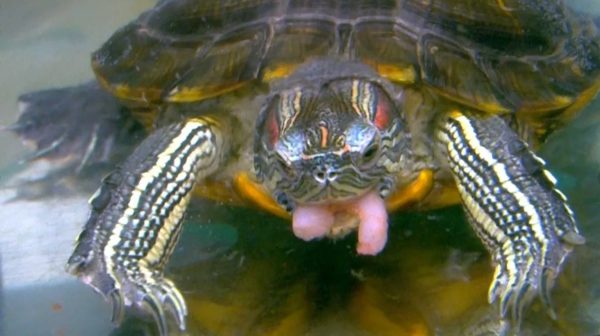
Protein food for red-eared turtles should be as close as possible to the conditions of the wild, which looks a little intimidating. The organization of hunting for live prey is an important point in the maintenance of predatory redworts. As live food you can use:
- aquarium fish: crucians, swordtails, guppies, goldfish;
- feed rats and mice (choose from bald, hairy and runners that reach no more than 9 cm);
- land insects: crickets, zofobas, caterpillars, earthworms;
- snails and frogs;
- aquatic insects: tubifex, bloodworm, daphnia (it is especially useful to feed bloodworm after a long fast associated with hibernation or illness).
IMPORTANT! Feeding with gammarus (mormysh) is acceptable as an additional source of food. Neither live nor dry gammarus can boast of vitamins useful for reptiles, and the hard chitinous shell complicates the digestion process. These crustaceans can be used as a treat by adding to dry food for red-eared sliders once a week.
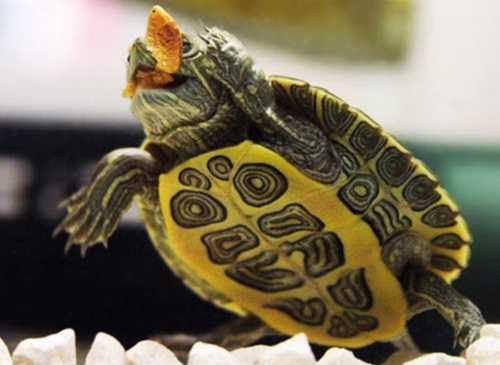
Turtles willingly eat snails, and thanks to the vitamins contained in meat, caviar and shell, you can regularly pamper your pets with this delicacy. Avoid wild poisonous clams and give preference to Achatina.
IMPORTANT! Before feeding the reptile, make sure that the shell does not have sharp tips that can damage the esophagus. Snails that are too large need to be crushed a little to make swallowing easier.
plant food
Red-eared turtles can be fed the following plant foods:
- vegetables. Reptiles are fed broccoli, zucchini, bell peppers, eggplant, pumpkin, carrots, beets or cucumbers. Eating legumes is dangerous due to bloating, but their leaves are a healthy and safe source of vitamins.
- Fruits and berries. Fruit and berry food is a real delicacy for the red-eared turtle. Treat your turtle with apricots, bananas, citrus fruits, apples, peaches, melons, plums or pears. Be sure to remove the seeds before feeding.
- Grass. In spring, summer and early autumn, you can treat your pet with grass near the house, pick clover, plantain, dandelions or coltsfoot. Sprouted oats or barley are suitable for nutrition in winter.
- aquarium plants. Turtles like to eat watercress, duckweed and water spirogyra. To avoid cloudy water, grow food plants in a separate aquarium.
- Mushrooms. You can add variety to the menu with the help of russula, boletus or champignons. Such a treat should be given no more than 1 time per week.
Artificial (industrial) food
At home, red-eared sliders can be fed ready-made food – a balanced nutrient mixture designed specifically for aquatic reptiles.
Despite the simplicity of such feeding, it is not recommended to choose it as a mono-food. Most manufacturers do not follow the balance recommended by veterinarians, so the animal may suffer from beriberi.
Ready-made foods are best fed as an additional source of food, giving preference to well-known brands:
1. Sera. German dry food suitable for adult and young red-eared turtles. The exception is the food “Sera Reptil Professional Carnivor”, intended for animals older than 2 years.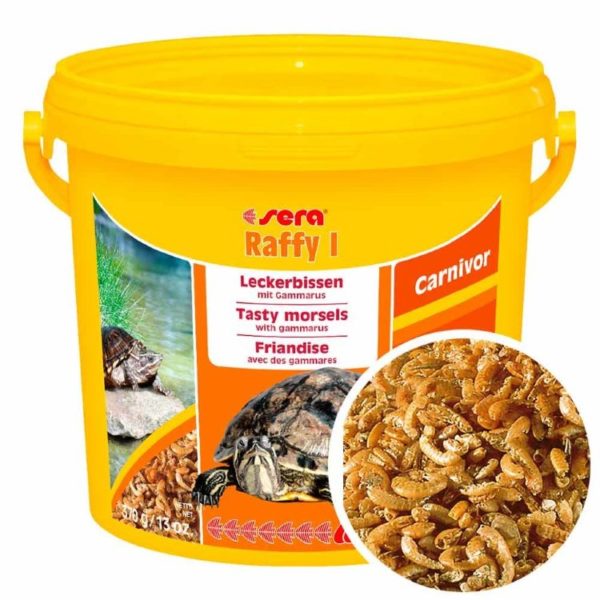 2. JBL. With an American brand, it is best to avoid JBL ProBaby, JBL Gammarus, and JBL Tortil, which contain eggs, milk, and gammarus.
2. JBL. With an American brand, it is best to avoid JBL ProBaby, JBL Gammarus, and JBL Tortil, which contain eggs, milk, and gammarus.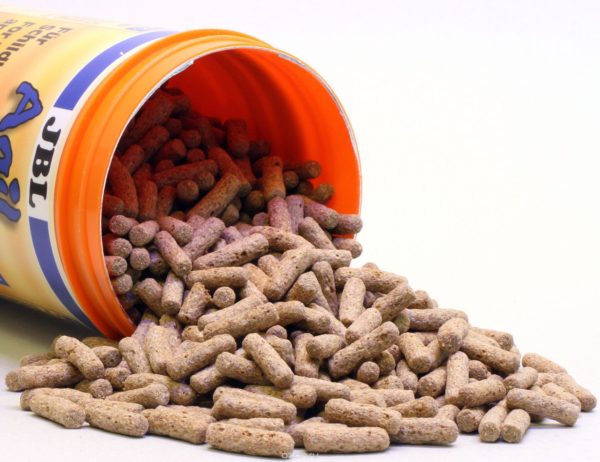 3. Tetra. Another German food recommended by veterinarians. For small red-eared turtles, the Tetra ReptoMin Baby line is suitable. Varieties with gammarus are best avoided, as the shell of the crustacean can cause tympania.
3. Tetra. Another German food recommended by veterinarians. For small red-eared turtles, the Tetra ReptoMin Baby line is suitable. Varieties with gammarus are best avoided, as the shell of the crustacean can cause tympania.
The most famous Russian company producing food for red-eared turtles is called Zoomir. The main disadvantage of its Tortila products is the presence of gammarus and brewer’s yeast. The possible harm of the first ingredient was described above, and the second is simply doubtful due to the lack of a specific benefit for the reptile.
IMPORTANT! When choosing food, pay attention to its composition. In the first place should be fish, shellfish, offal and insects. The presence of gammarus should be kept to a minimum. Its complete absence would be ideal.
If the store does not have decent food, then you can cook it yourself at home.
Homemade food
In order to cook food with your own hands you will need:
- mine – 1 kg;
- squid – 0,3 kg;
- cots – 0,5 kg;
- heck – 1kg;
- gelatin (agar-agar) – 150g;
- water – 750 ml.
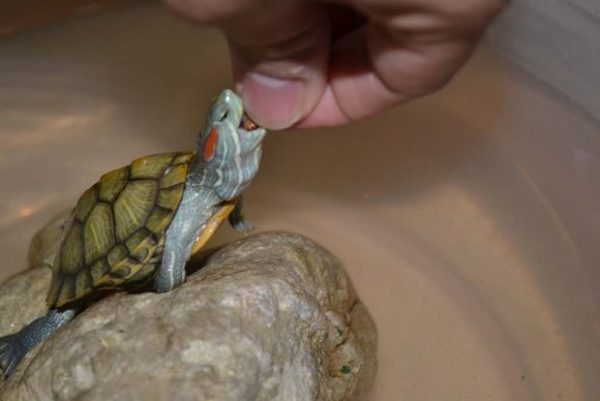
Preparation:
- Pass fish and seafood through a meat grinder.
- Dissolve gelatin in water and let it swell.
- Pass the minced meat with your hands or pestle. This will remove voids and excess air.
- Warm the minced meat over low heat for 10 minutes.
- Make holes in the minced meat and pour the dissolved gelatin into them.
- Mix thoroughly for 15 minutes.
- Pour the resulting mass on a kitchen tray or in a special container. They will help give the feed its final shape.
- Wait until it cools completely and put the mold in the refrigerator for 5 hours.
- Cut the hardened mass into small portioned pieces and wrap them in foil.
- Place the resulting pieces in the freezer. Before feeding, take out one of the servings and keep it at room temperature for 4 hours. A large red-eared turtle with a shell of 20 cm can be fed with the received food for 1 year.
IMPORTANT! If gelatin is replaced with agar-agar, then the portioned cube will melt longer in water. This will keep the aquarium free of food particles.
Feeding red-eared turtles one artificial food can result in digestive problems. Be sure to include plant and animal foods in your pet’s diet.
Video: cooking food
Prohibited products
Red-eared turtles should not be fed the following types of foods.
Food of animal origin
- Meat. Predatory reptiles are happy to eat beef and boiled chicken, but eating poultry and livestock meat is not natural for turtles. If you feed your turtle chicken, it may refuse fish, which will lead to digestive problems. It is also not permissible to give fatty meat (pork, lamb).
- Chicken eggs. Feeding boiled and raw eggs leads to bloating. Due to the lack of a diaphragm, there is strong pressure on the lungs and heart, and kidney function is deteriorating.
- Fish and Seafood. Limit the consumption of oily fish like sprat, herring or capelin, which causes intestinal sticking. Do not pamper your pet with crab sticks containing harmful additives. It is also not advisable to feed the turtle with squids, since in some cases they cause turbidity of the proteins.
- Insects. Feeding a red-eared turtle with domestic cockroaches can result in the death of an aquatic reptile. In the fight against mustachioed parasites, toxic chemicals are used that can harm the ruby.
IMPORTANT! Do not feed your pet maggots and slugs. The former have a distorted digestion system that dissolves everything outside the insect’s body and can harm the reptile’s stomach. The second, having lost their usual protection, begin to throw out toxins.
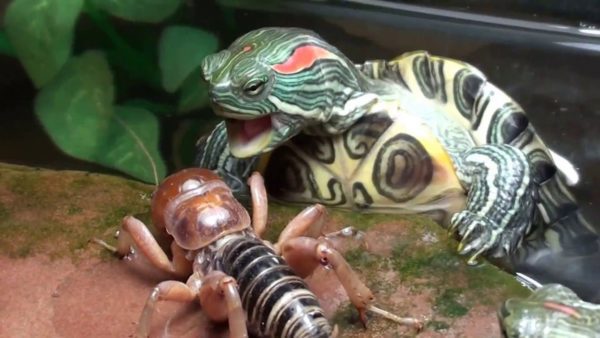
Plant feed
- Poisonous plants. The danger is represented by an aquarium elodea with a speaking alternative name “water plague”.
- Plants rich in phosphorus. These include tomatoes that prevent the absorption of calcium.
- Alkaline, goiter (causing iodine deficiency) and oxalate-rich plants. Do not give your pet cauliflower, mustard, radishes, legumes, asparagus, lemons, spinach, and pineapples.
- Seeds and nuts. Pitted pomegranates, cherries, plums, peaches and other fruits and berries are dangerous for redheads because of the cyanide they contain.
- Ready-made food for cats or dogs. Turtles should not be fed anything other than food formulated specifically for reptiles. Otherwise, the reptile will earn health problems.
- Dairy produce. The absence of special enzymes does not allow reptiles to digest milk, cottage cheese and cheeses, so such food will result in a stomach upset.
- Food from the human table. Smoked meats, sweets, canned food, fried and stewed dishes seasoned with spices are dangerous for turtles. It is also forbidden to give turtles bread that causes bloating due to the yeast it contains.
IMPORTANT! Giving meat to turtles too often is not recommended, as an excess of vitamin A can result in the development of rickets. The main part of animal feed should be fish.
Remember that the red-eared turtle should not be fed food that it could not get in the wild. It is unlikely that a reptile will learn how to milk a cow or be able to slaughter it.
Feeding rules
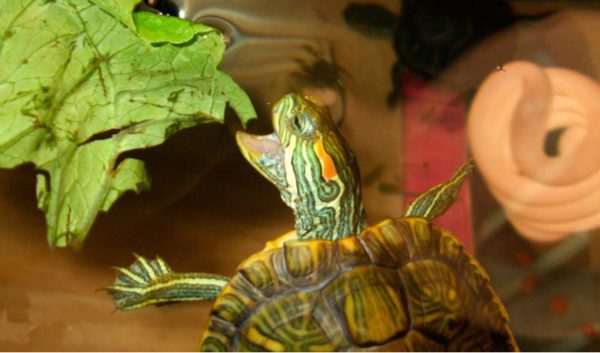

In order to properly feed your pet reptiles, follow these guidelines:
- Feed the turtle once a day in the morning or afternoon. In the evening, activity decreases, which complicates digestion.
- Leave food for only 30 minutes and do not overindulge in treats. At home, red-eared turtles feed on a regular basis, so they can become lethargic and spoiled.
IMPORTANT! If the pet refuses the offered food, reduce the portion size or arrange a temporary hunger strike.
- Arrange fasting days. Hunting in the wild is not always successful, so unloading 1 time per week will benefit the red-haired.
- Avoid overfeeding. The little red-eared tortoise eats like crazy, not knowing the sense of proportion. Indulging her appetite can be a big problem.
- Calculate the size of the feed, based on the size of the ruby. The turtle needs to be fed with pieces of food not exceeding half of its head.
IMPORTANT! The total amount of food calculated for 1 feeding should not exceed half of the reptile’s shell.
- Make sure food is at room temperature.
- Do not use 1 type of food. For the health of the domestic red-eared turtle, it is necessary to consume all types of permitted foods.
- Consult your veterinarian about vitamins. Mix approved additives with feed. Once a week, reptiles can eat bone meal and crushed eggshells, which replenish calcium reserves.
- Play with color. In the presence of red, orange or yellow, the red-eared turtle eats food more willingly. Try feeding her red apples, oranges, pumpkins, or melons with her food.
- Try to teach the red-eared to eat on land. Freshwater turtles live and feed in the water, so the aquarium becomes dirty after each feeding. Try placing your pet in a separate bowl filled with water and feeding it with tweezers.
IMPORTANT! It will not be possible to completely avoid contact with water, since redworts do not know how to produce saliva and use their pool to soften food.
Offal and insects should be given once a week, and fish and seafood at any time. Red-eared turtles love fish innards and will chew through small bones without any problems, so there is no need to gut the fish before serving.
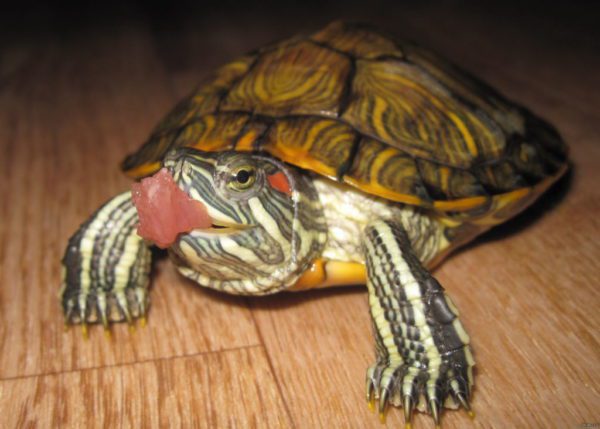

You should not feed the red-haired woman with the same 2 days in a row. Combine allowed foods and pamper your pet with her favorite treats:
- green shrimp containing healthy fats;
- live food that makes you feel like a real hunter;
- dried insects, available year-round in pet stores;
- seasonal fruits.
Features of feeding turtles
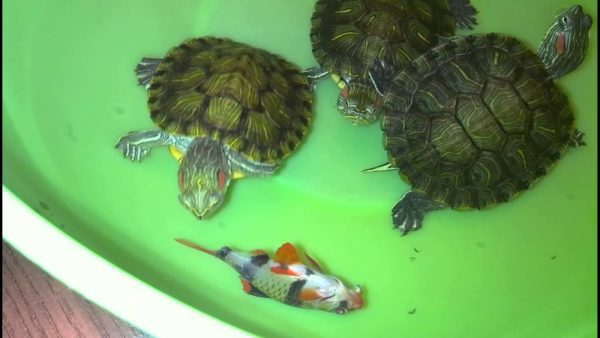

Up to 2 years of age, baby red-eared turtles should be fed a diet that is 90% animal food:
- offal (heart, liver);
- insects (bloodworms, daphnia, earthworms);
- boiled or soaked fish (crucian carp, perch);
- seafood (shrimp, mussels);
- aquarium fish (guppies, swordtails).
IMPORTANT! The young are fed daily.
Ready-made food designed specifically for small aquatic reptiles is also suitable for the red-eared turtle:
IMPORTANT! A pinch of bone meal or crushed eggshells, added to food on a daily basis, will help form strong shell shields.
Baby turtles can be given plant-based treats using sweet fruits, seasonal vegetables, or fresh grass. Go to such food should not be > 10% of the total diet.
A turtle with a carapace > 7 cm is already an adult reptile. From this age, the amount of plant food consumed gradually increases.
Feeding adults
For adult red-eared turtles, protein is already less important, so the amount of plant food can reach up to 30% or even 40%. Large aquatic reptiles are fed 2-3 times a week with any permitted foods, alternating them by day of the week.
IMPORTANT! For large red-eared turtles, it is required to increase the amount of bone meal to 1 tsp. for 1 meal, but reduce its consumption to 1 time per week.
When buying ready-made feeds, choose one of the manufacturers described above. This will save the pet from unforeseen consequences in case of eating low-quality food.
Table of allowed and prohibited products
The list of allowed and prohibited products can be found in more detail using the table as an example.
| Product | One can | Can be done in small quantities | Must not |
| Grains and cereals | Sprouted oats and barley | Any kind of cereal | |
| Vegetables | Lettuce greens | White cabbage | Rhubarb |
| Carrots | Broccoli | Radish | |
| Cucumber | Celery | Turneps | |
| squash | Spinach | Mustard | |
| Eggplant | Radish | ||
| Beetroot | Tomatoes | ||
| Bell pepper | Cauliflower | ||
| Pumpkin | pulse | ||
| Asparagus | |||
| Fruits and berries | peaches | Lemons | |
| Apricots | Pineapples | ||
| Apples | citrus zest | ||
| Banana | |||
| Melon | |||
| pears | |||
| Tangerines | |||
| oranges | |||
| plums | |||
| Strawberries | |||
| Watermelon | |||
| strawberry | |||
| Raspberry | |||
| Blackberry | |||
| Grass and aquarium plants | Dandelion | Sea kale | |
| legume leaves | Elodea | ||
| Riccia | Aquatic limnophila | ||
| Hornwort | |||
| Anacharis | |||
| Hibiscus | |||
| Plantain | |||
| Duckweed | |||
| Clover | |||
| Ceratopteryx | |||
| Mother and stepmother | |||
| Edogonism | |||
| Basil | |||
| Aloe leaves | |||
| Parsley | |||
| Tradescantia | |||
| Hornwort | |||
| Ludwigia | |||
| water hyacinth | |||
| Spirogram | |||
| Watercress | |||
| mushrooms | Russule | ||
| Boletus | |||
| Champignon | |||
| Seeds and nuts | Fruit and berry bones | ||
| Any nuts | |||
| Meat and offal | Liver | Rabbit meat | Pork |
| Heart | horsemeat | Lamb and other fatty meats | |
| Beef | Chicken eggs | ||
| Chicken (under the supervision of a herpetologist) | |||
| Dairy produce | Milk | ||
| Curd | |||
| Cheese and other dairy products | |||
| Fish | Crucian | Keta | Capelin |
| Blue whiting | Gobies | Salmon | |
| Bream | Pink salmon | Mackerel | |
| Pike | Perch | Acne | |
| Dace | Carp | Sturgeon | |
| Flounder | Salaca | Sayra | |
| Halibut | Whitefish | Herring | |
| Carp | Catfish | cod liver | |
| Smelt | Horse mackerel | Sprat | |
| Alaska Pollock | Sterlet | Salmon | |
| Navaga | Tuna | ||
| Burbot | Trout | ||
| Pangasius | |||
| Gudgeon | |||
| Zander | |||
| Cod | |||
| Trepang | |||
| Ide | |||
| Hake | |||
| Seafood | Snails (Achatina, coils, pond snail) | Squids (very carefully) | Slugs |
| Shrimps | caviar | ||
| Mussels | Sturgeon caviar | ||
| Crab | wild gastropods | ||
| Octopus | Crab sticks | ||
| oysters | |||
| Pollock roe | |||
| live food | Guppy | ||
| Swordsmen | |||
| Karasiki | |||
| Goldfish | |||
| Frogs | |||
| tadpoles | |||
| Feed mice and rats | |||
| Insects | Trumpeter | Dried Gammarus | Domestic and Madagascar cockroaches |
| Grasshopper | flour worm | Maggots | |
| Mokritsa | Bugs | ||
| Fireflies | |||
| Earthworms | |||
| Bloodworm | |||
| Corretra | |||
| Not shaggy caterpillars | |||
| Daphnia | |||
| Zophobas | |||
| Litter | |||
| feed cockroaches | |||
| fly larvae | |||
| Other | Bread | ||
| Sausages and sausages | |||
| Food for cats and dogs | |||
| Confection | |||
| Smoked meat | |||
| Canned food | |||
| Fried and stewed dishes seasoned with spices |
When feeding redworts, follow the basic rules that are responsible for proper nutrition. When choosing foods that are allowed in limited quantities, be careful and watch your pet’s reaction. If you have any worrisome symptoms, be sure to contact your veterinarian.
Video: 10 answers to the most popular questions about the nutrition of red-eared turtles


Watch this video on YouTube
What do red-eared turtles eat: a diet at home and the rules for choosing good food
3.4 (67.5%) 8 votes





